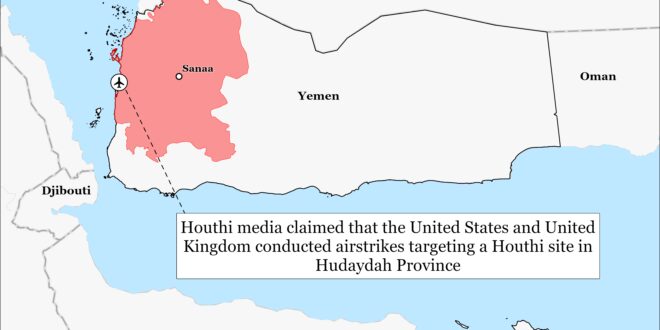Israeli state-owned broadcaster Kan published a US-drafted ceasefire proposal to end the fighting in Lebanon.[1] The draft proposes that international mediators determine a date to begin the ceasefire and commence a 60-day “implementation period.” During this period, Lebanese Hezbollah would cease attacks against Israel and the Israel Defense Forces (IDF) would cease offensive operations in Lebanon. The Lebanese Armed Forces (LAF) would gradually deploy 10,000 troops to southern Lebanon before the implementation period ends. The LAF would be responsible for monitoring the Israel-Lebanon border and all land, sea, and air crossings. The LAF would also dismantle all non-state military infrastructure and confiscate arms.
The United States, Israel, and Lebanon, according to the proposal, would establish a “monitoring and enforcement mechanism” to address reported ceasefire violations. The United States will administer the mechanism, which would—in addition to Israel and Lebanon—include the United Nations and European and regional countries. The mechanism would develop measures to address ceasefire violations, such as sanctions packages. The mechanism would assess progress at the end of the implementation period and institute a permanent ceasefire. The IDF would at this point conduct a complete withdrawal from Lebanon within seven days. The United States and United Nations would separately facilitate Israel-Lebanon negotiations to achieve the full implementation of UN Security Council Resolution (UNSCR) 1701, which prohibits Hezbollah from operating south of the Litani River. Hezbollah has violated UNSCR 1701 repeatedly over many years.
US, Israeli, and Lebanese officials are currently discussing the ceasefire proposal. Senior US officials Amos Hochstein and Brett McGurk met with Israeli leaders in Jerusalem on October 31 to that end.[2] Hochstein previously spoke with Lebanese Prime Minister Najib Mikati on October 30.[3] Israeli Army Radio reported that there has been ”real progress” toward an agreement.[4]
The success of this proposal depends fully on Hezbollah’s agreement and cooperation.[5] The proposal, in its current form, requires Hezbollah to cease attacks against Israel but does not explicitly require Hezbollah to disarm—only that the LAF must dismantle military infrastructure and confiscate weapons. The agreement could still be viable, however, so long as Hezbollah leaders accept the agreement and get their lower echelons to adhere to it. There is a risk that Hezbollah leaders cannot ensure that some of the rank-and-file militants stop attacks and surrender their weapons to the LAF, especially given the severe disruption to the Hezbollah command-and-control network. There may even be some exchanges of fire during the implementation period. This fighting would not necessarily mean that the ceasefire failed.
The LAF would need to disarm other non-state militias in southern Lebanon based on the text of the proposal. Hamas and Palestinian Islamic Jihad (PIJ) maintain cells in Lebanon, particularly in the south, and Hezbollah commonly allows these and other Palestinian groups to launch attacks into Israel from Hezbollah-controlled territory.[6] The presence of these armed groups could complicate Hezbollah efforts to honor the ceasefire.
The proposal does not explicitly require Hezbollah forces to withdraw from south of the Litani River.[7] The proposal instead stipulates that the LAF should be the only military force in the area.[8] This language is remarkably similar to that of UNSCR 1701, which calls for southern Lebanon to be “free any armed personnel, assets, and weapons” other than those of the Lebanese state.[9] UNSCR 1701 called in spirit for a Hezbollah withdrawal but fell short of providing for it explicitly.[10] Requiring Hezbollah to leave southern Lebanon would be extremely complicated given that many of Hezbollah militants were born and raised in the area that they would then need to leave.
Israel is seeking for the United States to guarantee its support for Israeli military action in Lebanon if the ceasefire fails.[11] The United States agreed to give Israel a “side letter” that would give assurances of US support if the LAF or UNIFIL fails to meet their respective obligations.[12] Maintaining the option to operate in Lebanon is consistent with Israeli Prime Minister Netanyahu saying on October 31 that the main Israeli priorities are to “enforce security, thwart attacks against [Israel], and act against the arming of our enemies despite all the pressures and constraints.”[13] The side letter requests that Israel consult the United States before any Israeli strikes in Lebanon and that the strikes try to minimize harm to civilians.[14] The United States also requested that Israeli flights over Lebanon be used only for intelligence collection and refrain from breaking the sound barrier.[15]
Senior Lebanese officials are expressing optimism publicly about the feasibility of a ceasefire. Lebanese Prime Minister Mikati said on October 30 that a deal could be announced “in the coming hours or days.”[16] Lebanese officials are reportedly avoiding criticizing any parts of the proposal publicly in order to provide space for continued negotiations.[17] The proposal published by Israeli media is dated October 26, but anonymous officials familiar with the negotiations have said that no major changes have been made since then.[18]
The IDF will establish a new division to counter threats around the Israel-Jordan border.[19] The division will include a quick reaction force to counter anti-Israel militancy in the Jordan Valley and to interdict weapons smuggling. The division will be subordinate to the IDF Central Command and cooperate with the Jordanian Army to secure the border region.[20] The establishment of this new division comes amid IDF concerns about Iran trying to smuggle weapons into Israel and the West Bank via Jordan.[21]
Key Takeaways:
Lebanon: Israeli media published a US-drafted ceasefire proposal to end the fighting in Lebanon. The success of the proposal depends fully on Hezbollah’s agreement and cooperation. The proposal does not explicitly require Hezbollah to withdraw from south of the Litani River.
Lebanon: Israel is seeking for the United States to guarantee its support for Israeli military action in Lebanon if the ceasefire fails. Senior Lebanese officials are expressing optimism publicly about the feasibility of a ceasefire.
Israel: The IDF will establish a new division to counter threats around the Israel-Jordan border. The establishment of this division comes amid IDF concerns about Iran trying to smuggle weapons into Israel and the West Bank via Jordan.We do not report in detail on war crimes because these activities are well-covered in Western media and do not directly affect the military operations we are assessing and forecasting. We utterly condemn violations of the laws of armed conflict and the Geneva Conventions and crimes against humanity even though we do not describe them in these reports.
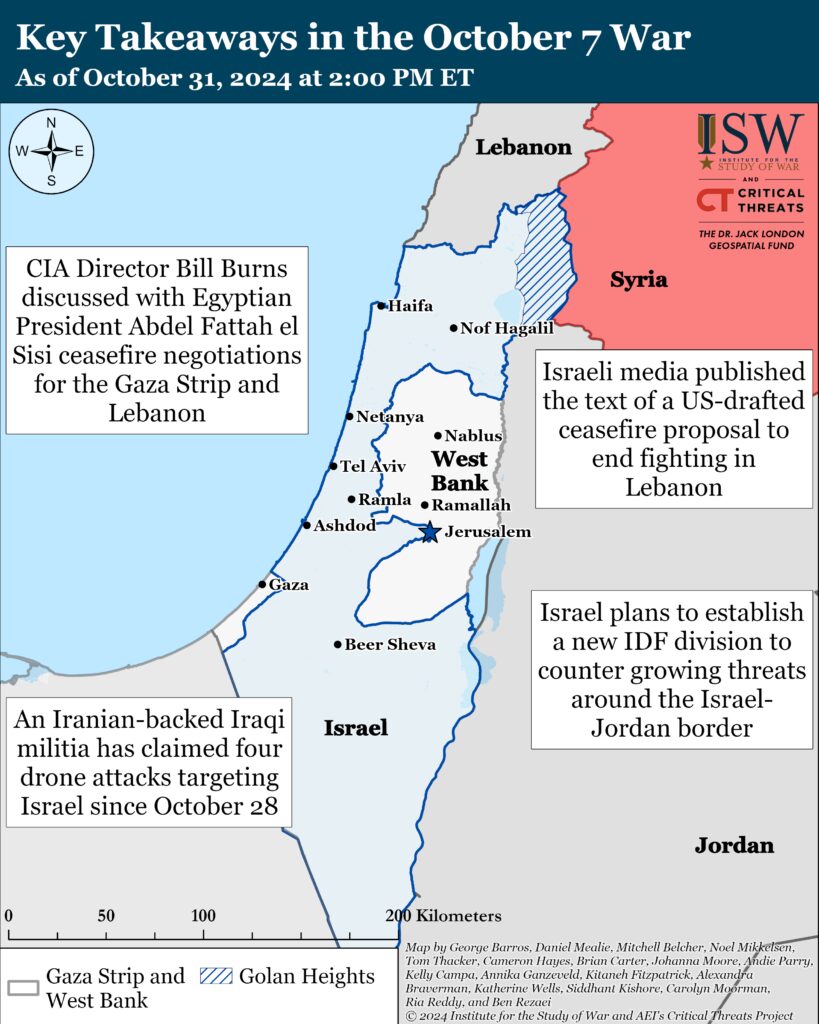
Gaza Strip
Axis of Resistance objectives:
Erode the will of the Israeli political establishment and public to sustain clearing operations in the Gaza Strip
Reestablish Hamas as the governing authority in the Gaza StripThe IDF 162nd Division continued clearing operations in Jabalia, northern Gaza Strip, on October 31. Israeli forces raided dozens of Palestinian militia sites, including weapons warehouses, in Jabalia.[22] Israeli forces have detained hundreds of Palestinian fighters in Jabalia since resuming clearing operations there on October 6.[23] The IDF stated that the ”surrender” of Hamas fighters in Jabalia area indicates that Hamas is collapsing there.[24] Palestinian Islamic Jihad (PIJ) attacked Israeli armor with two explosively formed penetrators (EPF) east of Jabalia and west of Beit Lahia.[25] It is notable that Palestinian militias continue to conduct EPF attacks, given the specialized components needed to manufacture the device. Palestinian fighters also fired rockets targeting Israel forces west of Jabalia.[26]
The IDF 252nd Division continued operations around the Netzarim Corridor, south of Gaza City, on October 31.[27] The IDF destroyed a Hamas munitions manufacturing site in the central Gaza Strip.[28] The IDF provided no details on the size or sophistication of the site. The presence of such a site could indicate meaningful Hamas reconstitution efforts, depending on the production capacity of the site and what it was producing. Commercially available satellite imagery published on October 30 shows flattened terrain south of the Netzarim Corridor, indicating military activity there. Palestinian militias conducted four rocket attacks targeting Israeli forces around the corridor.[29]
The IDF 143rd Division continued operations in Rafah around the Philadelphi Corridor on October 31.[30]

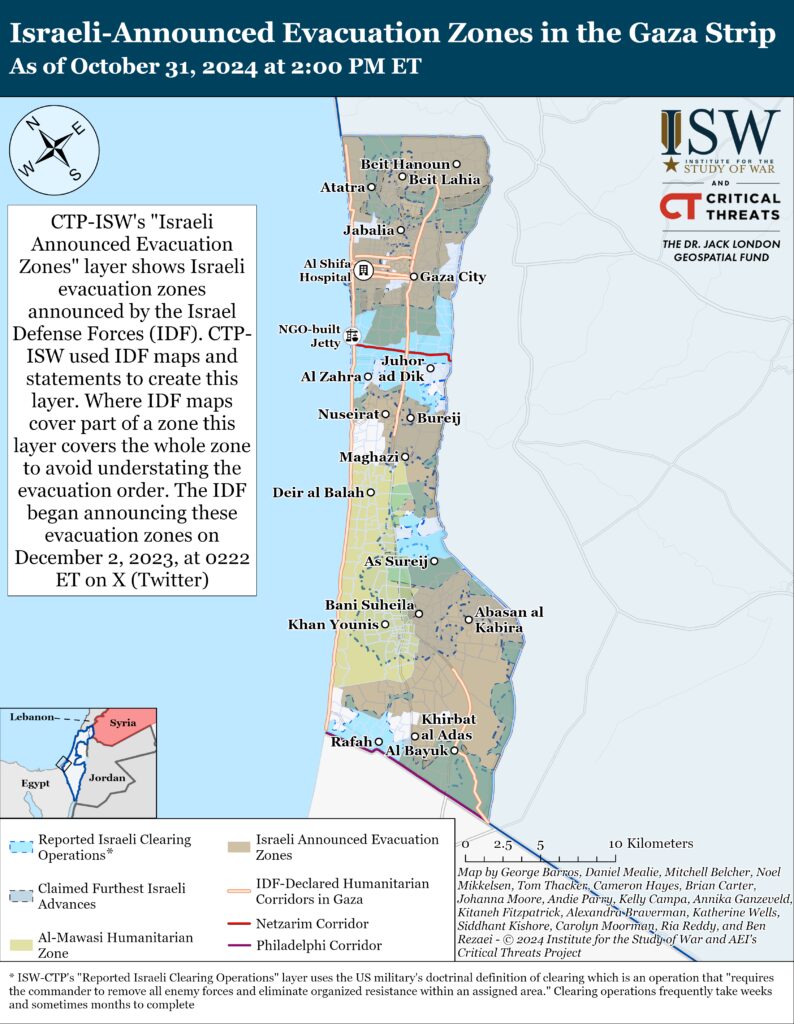
CIA Director Bill Burns discussed possible ceasefires for the Gaza Strip and Lebanon with Egyptian President Abdel Fattah el Sisi and Egyptian intelligence chief Hassan Rashad in Cairo on October 31.[31] Sisi publicly proposed an initial two-day ceasefire in which four Israeli hostages would be exchanged for an unspecified number of Palestinian prisoners.[32] The two-day ceasefire would be followed by 10 days of further negotiations. Israel and international mediators began sharing new ceasefire proposals after Israel killed Hamas leader Yahya Sinwar in the Gaza Strip on October 16. CTP-ISW continues to assess that Sinwar’s death is unlikely to prompt a shift in Hamas strategy in the war or in ceasefire-hostage negotiations.[33] Hamas leaders reiterated on October 31 their maximalist demands of a full Israeli withdrawal from the Gaza Strip and permanent ceasefire.[34]
West Bank
Axis of Resistance objectives:
Establish the West Bank as a viable front against IsraelThe IDF thwarted a weapons smuggling attempt from Egypt into Israel on October 31.[35] The IDF intercepted a small quadcopter drone that crossed from Egypt into Israel and contained four rifles and a handgun. The IDF previously intercepted a similar drone that carried weapons over the Egypt-Israel border on October 19.[36]
Israeli forces conducted overnight raids on October 30 and 31 in Tulkarm and killed a local Hamas commander.[37] The IDF killed Hussam al Malah, who was planning near-term attacks against Israel.[38] Malah reportedly commanded a Hamas cell that had planned to conduct a “major terror attack” on the anniversary of the Hamas October 7 attack into Israel.[39] The IDF has killed two other members of the Malah-led cell in recent days.[40] The IDF separately conducted an airstrike targeting a Palestinian militia cell that fired small arms targeting Israeli forces in Nour Shams refugee camp in Tulkarm.[41]
Israeli forces have engaged Palestinian fighters in at least two locations across the West Bank since CTP-ISW’s last data cut off on October 30. PIJ detonated several improvised explosive devices (IED) targeting IDF armored personnel carriers and bulldozers in Nour Shams refugee camp.[42] PIJ claimed that it ambushed Israeli forces in several locations in Nour Shams camp by firing small arms and detonating IEDs.[43] The al Aqsa Martyrs’ Brigades fired small arms and detonated IEDs targeting Israeli forces in Tulkarm refugee camp as well.[44]
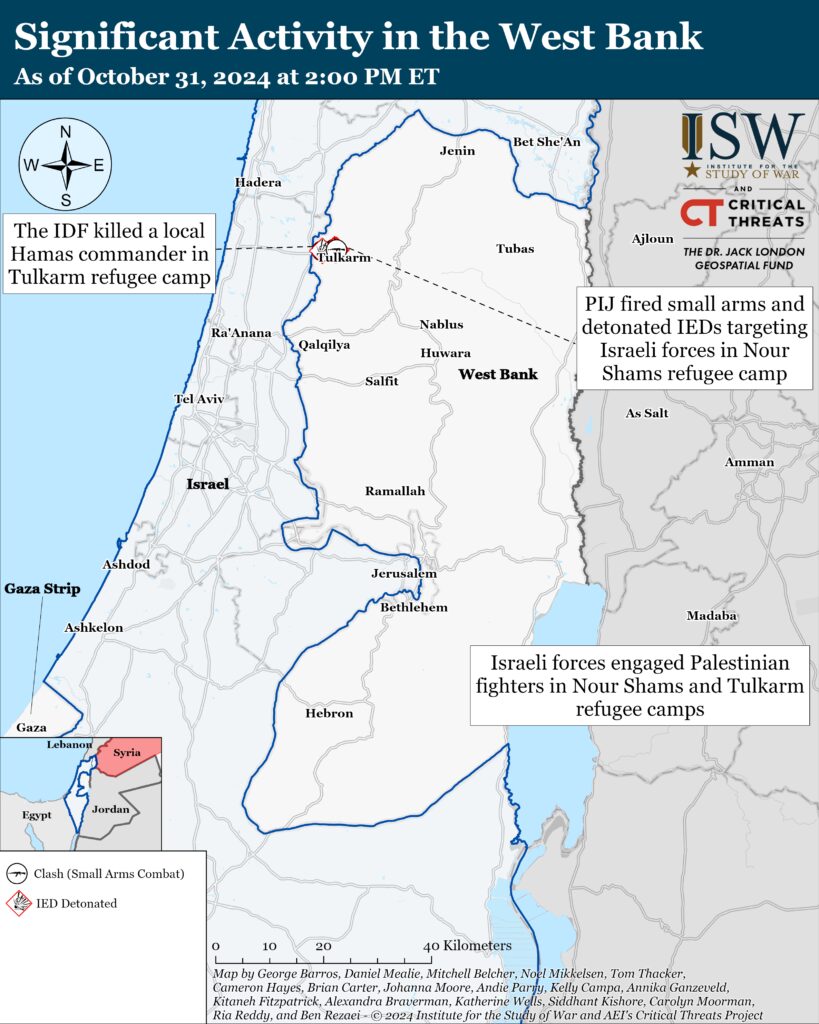
Northern Israel and Lebanon
Lebanese Hezbollah objectives:
End Israeli operations in the Gaza Strip
Survive the October 7 War as a capable political and military organization with control over LebanonIsraeli forces continued to conduct clearing operations and seize terrain in southern Lebanon on October 31.[45] Israeli forces destroyed Hezbollah infrastructure and killed Hezbollah militants.[46] The IDF conducted an airstrike targeting a Hezbollah anti-tank squad in a civilian area.[47]
Hezbollah has continued to engage Israeli forces around Khiam, southeastern Lebanon, since CTP-ISW’s data cutoff on October 30. Hezbollah claimed 13 separate mortar and rocket attacks targeting Israeli forces around Khiam.[48] Lebanese media reported small arms combat between Israeli forces and Hezbollah militants around Khiam.[49]
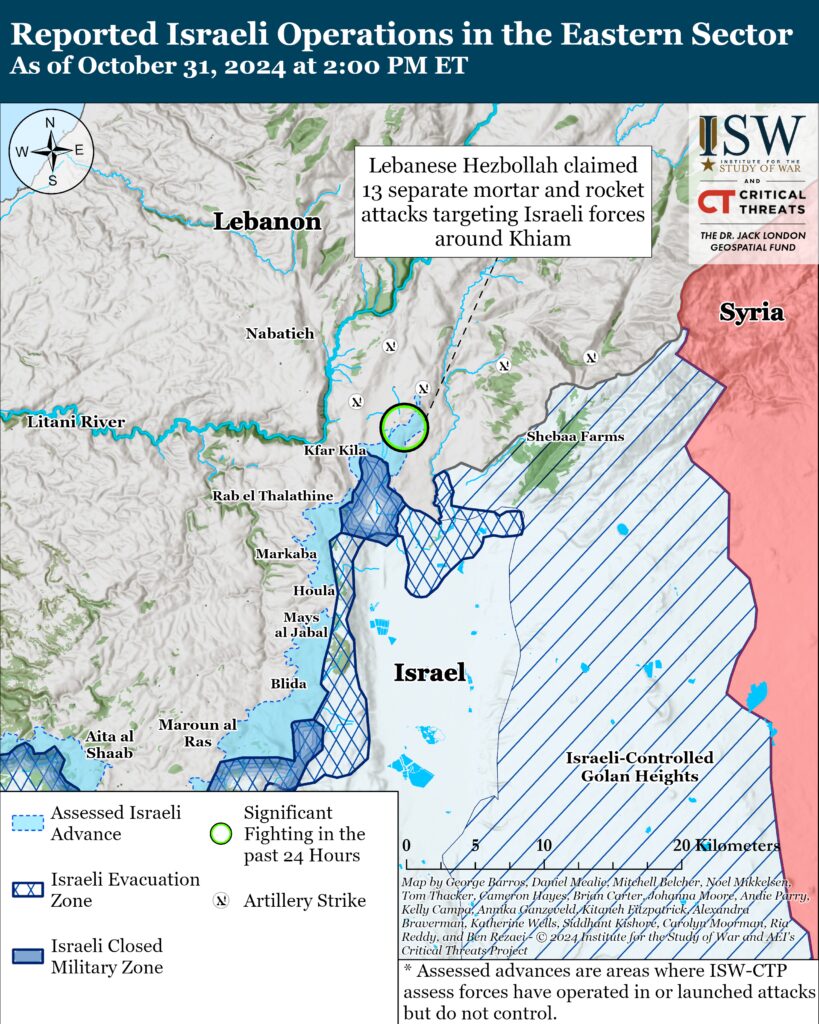
The IDF 205th Armored Brigade (146th Division) located and destroyed Hezbollah underground infrastructure, observation posts, and weapons caches in southwestern Lebanon.[50] The 205th Armored Brigade also located and destroyed a camouflaged Hezbollah vehicle that contained rifles, bulletproof vests, and various other kinds of military equipment. The 205th Armored Brigade killed Hezbollah militants via ground engagements and by directing airstrikes targeting them. Israeli forces separately located Hezbollah rocket launchers that were prepared to fire into Israel. Commercially available satellite imagery showed destroyed buildings in western Dahyra, southwestern Lebanon, indicating that Israeli forces have conducted clearing operations there.
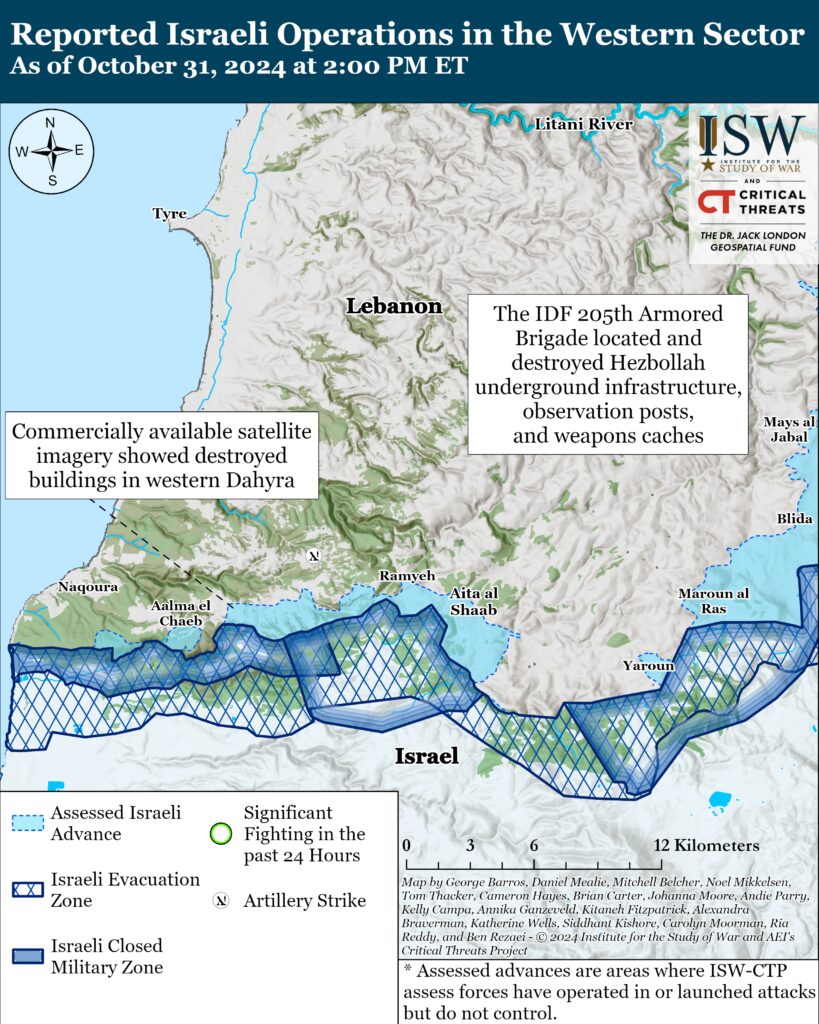
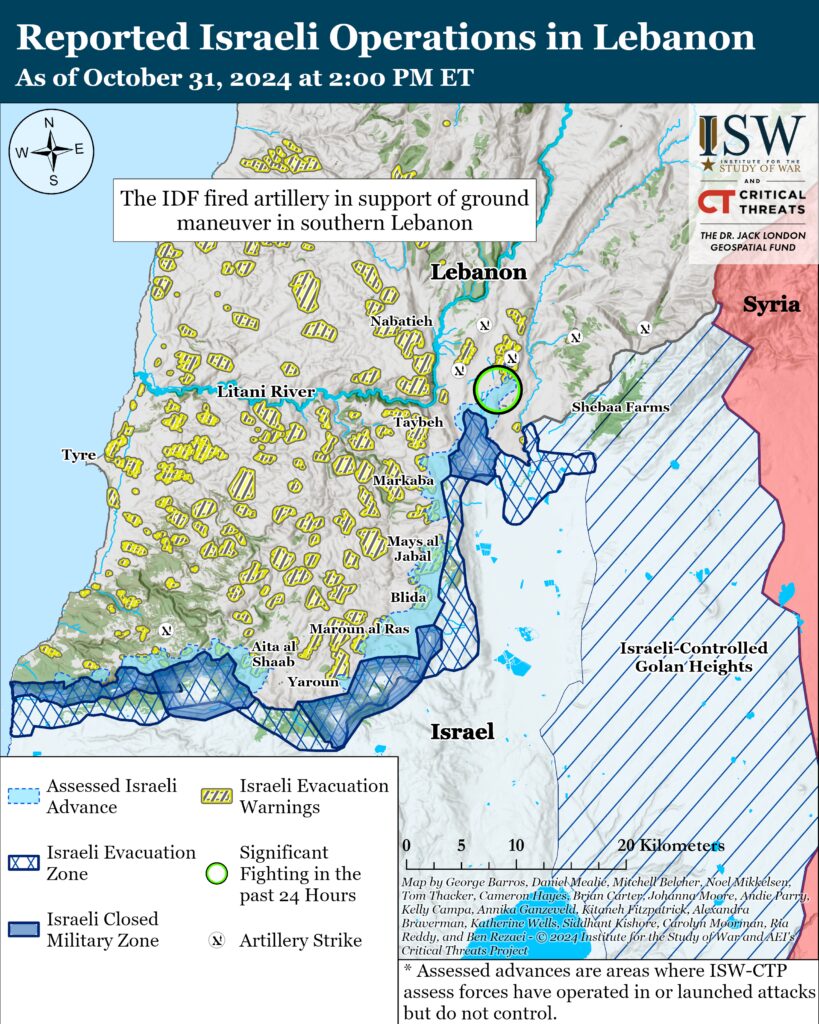
This map illustrates individual Israeli air and artillery strikes based on local Lebanese reporting. This map depicts strikes reported from 2:00pm ET on October 30 to 2:00pm ET on October 31. This map is not exhaustive. CTP-ISW cannot independently verify the locations of Israeli strikes.
Iranian-backed Iraqi militants are fighting and dying in southern Lebanon, according to an Iranian-backed Iraqi militia source.[68] The source told Baghdad Today that that the militants were already deployed to Lebanon when fighting began but that the Iranian-backed Iraqi militias “did not enter the battle with all their weight.”[69] CTP-ISW previously assessed that Iranian-backed groups have likely embedded their militants with Hezbollah forces in Lebanon.[70]
Hezbollah has conducted at least 12 attacks into Israel since CTP-ISW’s last data cutoff on October 30.[71] Hezbollah rocket attacks killed seven Israeli civilians in northeastern Israel on October 31.[72] This high casualty count is abnormal, though it is unclear whether the attacks mark a change in Hezbollah tactics. An Israeli Army Radio correspondent reported that Hezbollah rockets killed five farmworkers in Metula and two other civilians in Kiryat Shmona.[73] Hezbollah conducted two rocket attacks targeting Israel forces and civilians in Kiryat Shmona.[74] Hezbollah launched a one-way attack drone targeting Israeli forces in Shomera, which is adjacent to where some Israeli forces are in southern Lebanon.[75] Hezbollah also fired rockets targeting Israeli warehouses near Acre, northwestern Israel.[76]
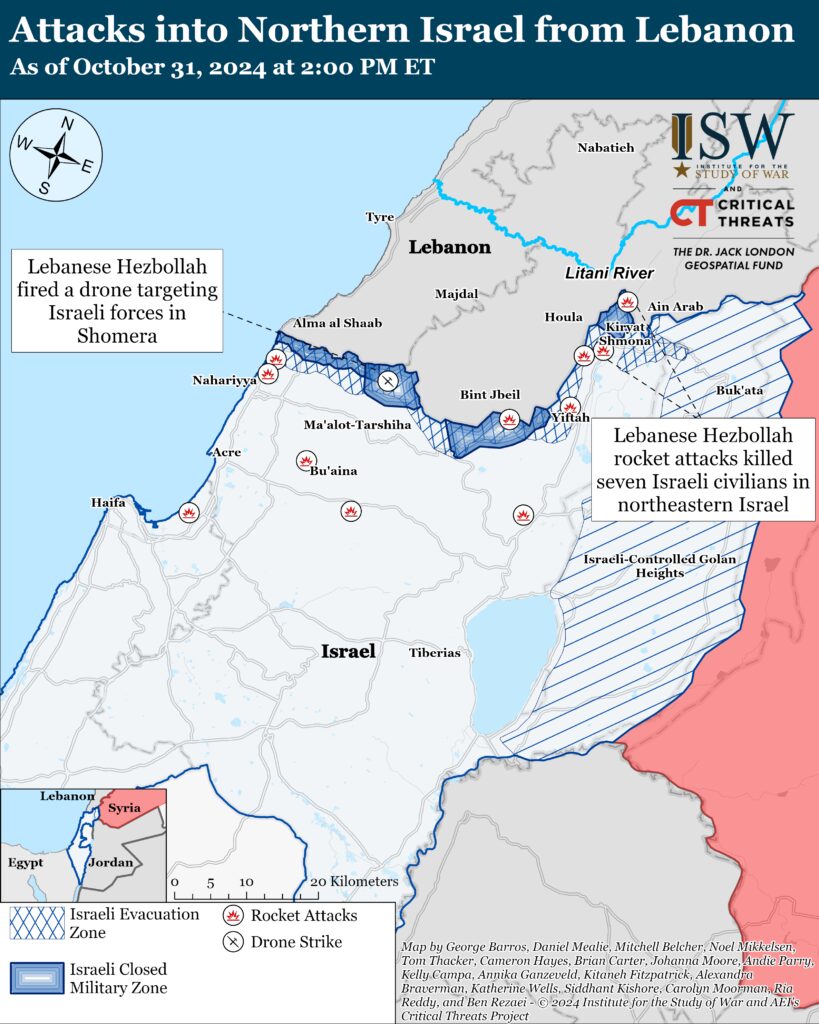
Iran and the Axis of Resistance
The Islamic Resistance in Iraq—a coalition of Iranian-backed Iraqi militias—has claimed six attacks targeting Israel since CTP-ISW’s last data cutoff on October 30. The claims include:
Three drone attacks targeting unspecified “vital target[s]” in the Golan Heights[77]
Two drone attacks targeting unspecified “vital target[s]” in northern Israel[78]
A drone attack targeting an unspecified “vital target” in southern Israel[79]The IDF detected a drone that approached Israel from the east on October 30.[80] The drone struck the northern Golan Heights, causing no casualties or damage.
Iranian-backed Iraqi militia Saraya Awliya al Dam has claimed four attacks targeting Israel since October 28. Saraya Awliya al Dam professes to be affiliated with the Islamic Resistance in Iraq and appears to claim distinct attacks targeting Israel.[81] Saraya Awliya al Dam is likely a cover group for Iranian-backed Iraqi militias Kataib Hezbollah or Harakat Hezbollah al Nujaba.[82] Saraya Awliya al Dam has claimed 20 drone attacks targeting Israel between May 29 and October 27.[83] Saraya Awliya al Dam’s latest claims include the following:
A drone attack targeting a “vital target” in the Golan Heights on October 28[84]
A drone attack targeting a “vital target” in Haifa on October 29[85]
A drone attack targeting a “vital target” in Tiberias on October 29[86]
A drone attack targeting a “vital target” in the Jordan Valley on October 29[87]CTP-ISW is unable to independently verify these attacks occurred.
Iranian-backed Iraqi militia Kataib Hezbollah spokesperson Ali Abu Askari released a statement threatening to “strike in the heart of the capitals” of countries supporting ISIS and Israel on October 31, possibly referring to the United States.[88] Iran commonly claims that the United States supports ISIS.[89] Kataib Hezbollah is a part of the Islamic Resistance of Iraq that conducted over 170 attacks targeting US troops in Iraq and Syria between October 2023-January 2024.[90]
Islamic Revolutionary Guards Corps (IRGC) Quds Force Commander Brigadier General Esmail Ghaani reaffirmed Quds Force support for Hezbollah against Israel on October 31.[91] Ghaani made this statement in a condolence message for former Hezbollah Secretary General Hassan Nasrallah and former Hezbollah Executive Council Chairman Hashem Safi ed Din.[92] Ghaani also congratulated newly appointed Hezbollah Secretary General Naim Qassem on succeeding Nasrallah.[93]
Houthi media claimed on October 31 that the United States and the United Kingdom conducted an airstrike targeting an unspecified site near al Hudaydah University in Hudaydah Province, Yemen.[94] US Central Command has not confirmed the strike at the time of this writing.
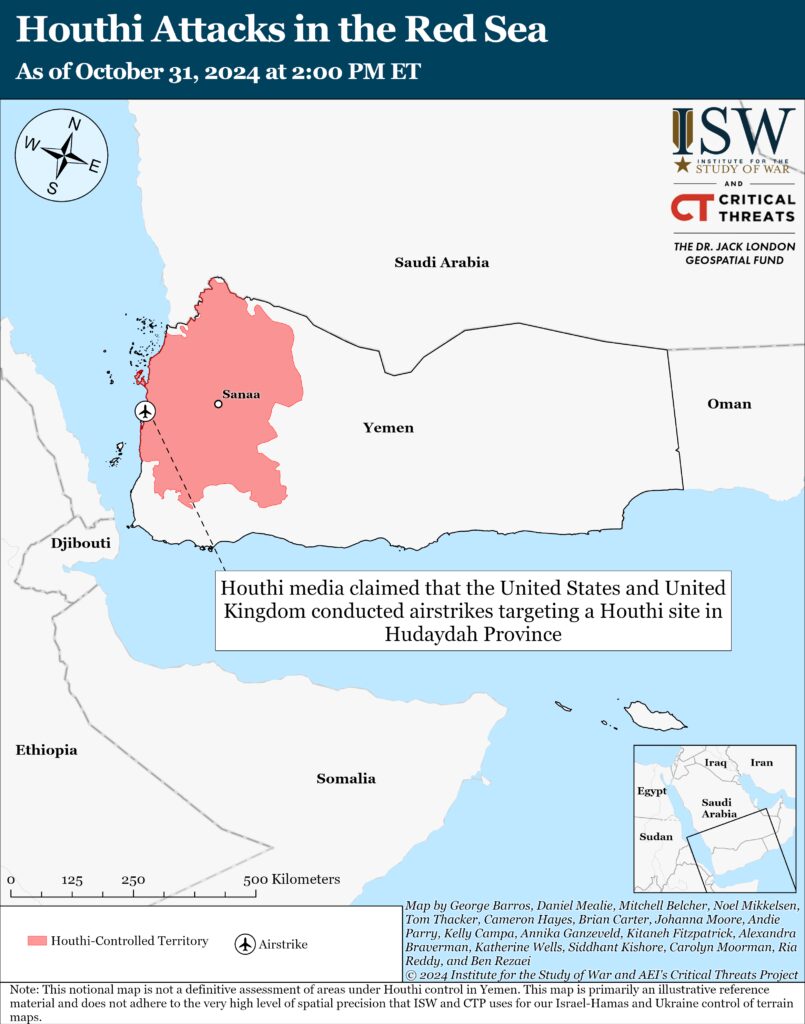
Iranian Foreign Affairs Minister Abbas Araghchi held separate phone calls with his Algerian and Indonesian counterparts on October 31.[95] Araghchi highlighted the importance of Islamic countries condemning Israel’s campaigns in the Gaza Strip and Lebanon and asked both officials to support an Iranian call for a United Nations Security Council meeting. Araghchi also wrote an op-ed in Indonesian newspaper Jakarta Times, where he reflected on 75 years of diplomatic relations between Iran and Indonesia.[96] Araghchi -emphasized the importance of former Iranian President Ebrahim Raisi’s trip to Indonesia in May 2023 that resulted in 11 memorandums of understanding across various sectors between the two states.[97] Araghchi noted that the Pezeshkian administration intends to prioritize trade with eastern and southeastern Asian countries.[98]
Prominent clerics called on Iranian President Masoud Pezeshkian to address the growing economic issues. Pezeshkian visited Qom on October 31 and held separate meetings with Grand Ayatollah Naser Makarem Shirazi, Grand Ayatollah Abdollah Javadi Amoli, Grand Ayatollah Jafar Sobhani, Grand Ayatollah Hossein Nouri Hamedani, Grand Ayatollah Mousa Shubairi Zanjani, Hojjat ol Eslam Sheikh Javad al Shahrastani, and Hojjat ol Eslam Wal Muslimin Saeedi.[99] Grand Ayatollah Naser Makarem Shirazi warned against raising fuel prices, likely referring to Pezeshkian’s proposed budget for the next Persian calendar year.[100] The proposal suggests increasing fuel prices to address government deficits amid growing domestic fuel consumption.[101] Iranian parliamentarian Ahmad Rastineh separately criticized the proposal for its potential negative impact on the economy.[102] Grand Ayatollah Nouri Hamedani emphasized the need to remedy the declining value of the Iranian rial against other currencies during his meeting with Pezeshkian.[103]
The Iranian Intelligence and Security Ministry announced on October 31 that it intercepted Kurdish militants trying to enter Iran from Iraqi Kurdistan on October 28.[104] The operation—supported by the IRGC Ground Forces—killed one of the militants.[105]
Jaish al Adl—a Baloch Salafi-jihadi group—launched an attack on a police station in Sistan and Baluchistan Province on October 30.[106] The Iranian Law Enforcement Command (LEC) claimed that the assailants opened fire on the station but fled the scene after encountering countermeasures from security forces. Jaish al Adl previously killed ten Iranian LEC officers in an attack on a police patrol unit in Taftan County, Sistan and Baluchistan Province, on October 26.[107] This activity is part of a general increase in anti-regime militancy in southeastern Iran since December 2023.[108]
 Eurasia Press & News
Eurasia Press & News
